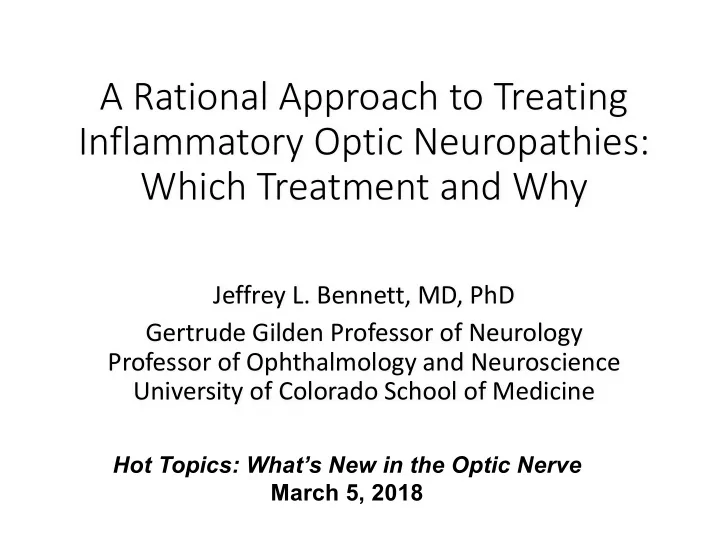

A Rational Approach to Treating Inflammatory Optic Neuropathies: Which Treatment and Why Jeffrey L. Bennett, MD, PhD Gertrude Gilden Professor of Neurology Professor of Ophthalmology and Neuroscience University of Colorado School of Medicine Hot Topics: What’s New in the Optic Nerve March 5, 2018
Di Disclos osures • Research Grant: EMD-Serono • Consultant • Novartis • Genzyme-Sanofi • Genentech • MedImmune • Chugai • Teva Pharmaceuticals
Obj Objec ectives es • Enumerate immune and infectious causes of inflammatory optic neuropathy. • List clinical and diagnostic data impacting treatment of inflammatory optic neuropathy. • Describe data supporting various treatments of acute inflammatory optic neuropathy. • List inflammatory optic neuropathies with high risk of poor visual recovery or recurrent disease.
Ra Ration onal Approa oach to o ON N Treatment • Etiology • Prognosis • Therapeutic Options/Data • Risk of Recurrent Disease • Preventative Therapy
ON ON: : Differ eren ential al Diag agno nosis • Infection • Ischemia • Toxic • Genetic
Infectious Optic Neuropathy • Bilateral • Optic Disc Heme • Ocular Inflammation • Uveitis • Iritis • Retinitis
Treatment of Infectious Causes of ON Etiology Common Clinical Features Treatments Syphilis (Treponema) Uveitis, chorioretinitis, vasculitis, Penicillin papillitis (varied) Cat-scratch (Bartonella) Neuroretinitis (macular star) Corticosteroids; antibiotics: azithromycin, ciprofloxacin, tetracycline, sulfamethoxazole- trimethoprim Lyme Disease (Borrelia) Optic disc edema; reports of Ceftriaxone; doxycycline intermediate uveitis or papilledema Tuberculosis Papillitis, uveitis, neuroretinitis Isoniazid, rifampicin, pyrazinamide, (Mycobacteria) ethambutol Viral Variable: mild optic disc edema, HAART (HIV); acyclovir (VZV) (WNV, HIV, VZV) chorioretinitis, vitritis (WNV); normal, mild microangiopathy (HIV); hemorrhagic optic disc edema, cotton wool spots (VZV)
Inflammatory Causes In es of ON Etiology Common Clinical Features Treatments NMOSD Recurrent, MRI-optic nerve IVSM; PLEX enhancement/extensive lesions; chiasm, NMO-IgG MOG Recurrent; MRI-optic nerve Corticosteroids – may enhancement/extensive lesions; MOG- require prolonged IgG treatment GFAP Optic disc papillitis; MRI-perivascular Corticosteroids enhancement; GFAP-IgG Paraneoplastic Bilateral; disc edema; vitreal cell; vascular IVIg; PLEX; leakage; paraneoplastic antibodies corticosteroids; identify and remove inciting neoplasm Idiopathic Multiple Sclerosis Occasional mild disc edema; MRI-optic IVSM; PLEX Other (CRION, AON) nerve enhancement/T2 signal Corticosteroids Recurrent, isolated; MRI-optic nerve enhancement/T2 signal; IgG on skin biopsy Corticosteroids; TNF- a Sarcoidosis Optic disc edema; ocular inflammation; multi-system disease blocker
Inflammatory Optic Neuritis: Clinical Suspicion • NMOSD • Severe vision loss/field loss (<20/200; MD <11dB) • MRI: Posterior optic nerve or chiasm involvement • MOG-IgG • Recurrent optic neuritis; simultaneous TM and ON • Steroid sensitive • MRI: Significant ON nerve/sheath enhancement • RION/CRION/AON • Recurrent optic neuritis • Steroid sensitive • Paraneoplastic • Subacute onset, older age; painless • Vitreal cell, retinal vascular leakage • Sarcoidosis • Acute or subacute onset; ocular inflammation • MRI: Perineuritis, chiasmitis, enlargement/enhancement optic nerve • GFAP-IgG • Meningoencephalitis; papillitis
ON ON: : MRI and and OC OCT Sarcoid NMOSD >15 micron loss MOG-ON Jurynczyk et al. Brain 2017: 140; 3128 Pache et al. J Neuroinflammation 2016;13(1):282. Naismith et al. Neurology (2009) vol. 72: 1077 Ratchford et al. Neurology (2009) vol. 73: 302
Laboratory Clues –Serology and CSF • Serology • ANA: NMOSD and MOG-IgG (~42%) • Anti-neural antibodies: GFAP-IgG • NMDA-R-IgG, anti-GAD65, ion channel antibodies • Thyroid Abs – 16.7% • AchR Abs – 11%; Anti-GAD Abs – 15% • CSF • MOG-IgG: Pleocytosis ≥100 cells/ml • Oligoclonal bands: MS-related, GFAP-IgG • Eosinophils: NMOSD Pittock, Arch Neurol (2008); McKeon, Muscle & Nerve (2009); Jarius, J Neuroinflamm (2016); Flanagan, Ann Neurol (2017)
Optic Neuritis Treatment Trial (ONTT) No difference in visual acuity between steroid and placebo groups at 6 months*. *Increase in the rate of normalization of visual field, contrast sensitivity, and visual acuity (NEJM 326:581, 1992)
Visual Prognosis MOG-IgG • Average recovery after vision loss • NMOSD: logMAR 0.4 (~42% worse than 1.0) • MOG-IgG: 20/20 • Sarcoidosis: 20/40 • CRION/RION/AON & GFAP-IgG: “Good” • High risk of relapse • NMOSD: 63% by 1 year untreated • ARR w/treatment: 0.38 (0.04-2.25; N = 83) • MOG-IgG MOG-IgG Collongues, et al. (2010). Neurology, 74:736 Jarius et al. (2012). J Neuroinflamm, 9:14. Weinshenker et al. (2006). Neurology, 59:566–569. Jurynczyk et al. Brain 2017: 140; 3128 Kidd et al., Brain 2003; 126:276
Staging Acute Therapy Recovery from attack is often incomplete PLEX: More complete responders Serial treatment generally moves non-responders to partial responders Kleiter et al. (2016). Ann Neurol, 79:206. Merle et al., (2012). Arch Ophthalmol, 130:858 N= 189 12 N= 73 10
NMO Pathogenesis Human Pathology Future Therapies? • Anti-complement Therapy • Anti-C5 complement • C1q esterase inhibition • Anti-neutrophil elastase • IVIg
Minimal Pathology in MOG-IgG Disease Pathology Experimental Systems Type II MS Pathology: Lymphocytic infiltrate, IgG, complement T cell B cell Mac IgG Ast Comp Spadara et al., (2015) Ann Clin Transl Neurol, 2:295; Jarius et al., (2016) Mult Scler, 22:1541 Saadoun et al. (2014), Acta Neuropathol Comm, 2:35 Peschl et al. (2017), J Neuroinflamm, 14:208
Rational Approach to Optic Neuritis Treatment • Identify the cause • Infectious or non-infectious • Clinical, imaging, laboratory clues • Prognosis • Generally good • Recurrent ON and NMOSD are likely exceptions • Treatment • Intravenous methylprednisolone • Early plasma exchange for NMOSD and recurrent ON • Lingering Questions • Combination Therapy • Direct treatment of immune effectors (CDC, ADCC) • Early use of immunosuppression/immunomodulators
Recommend
More recommend